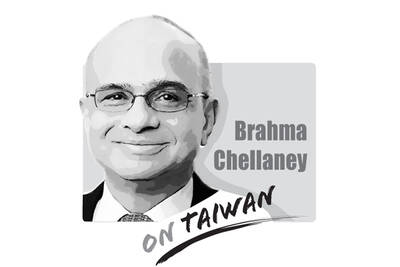President Ma Ying-jeou (馬英九) wiped out almost 10 years of progress made under former presidents Lee Teng-hui (李登輝) and Chen Shui-bian (陳水扁) in one fell swoop last week when he told a Mexican newspaper that the relationship between Taiwan and China “is a special one, but not [one] between two countries.”
By turning back the clock to before Lee’s 1999 “state-to-state relations” declaration, Ma’s statement was a marked departure from his pre-election pledges to defend Taiwan’s sovereignty, a fact the Presidential Office was quick to “clarify.”
In the same interview, Ma also referred once again to the fictitious “1992 consensus,” saying that both sides of the Taiwan Strait had agreed to accept the “one China, different interpretations” model supposedly enshrined in this fabricated agreement.
He was wrong. At no time has Beijing said it subscribes to the so-called “consensus” and China’s outright rejection of the Ma government’s self-
deprecating UN bid two weeks ago is clear proof that Beijing will brook no deviation from its definition of the “one China” policy.
But while the rest of the world recognizes rejection when they hear it, the Presidential Office persists in trying to disguise a failure as a success, dismissing Beijing’s sharp rebuff as an “isolated incident.”
George Orwell could have been talking about the Ma government when, in his influential 1946 essay “Politics and the English Language,” he wrote “political speech [is] largely the defense of the indefensible and consists largely of ... sheer cloudy vagueness.”
The Ma administration has purposely played word games with national sovereignty in the belief that it can earn mutual goodwill from China. As Ma’s campaign promises were predicated on Beijing’s willingness to throw Taiwan a few crumbs from its economic banquet, the government has had no choice. Yet 100 days on, Ma has nothing to show for his government’s ingratiating behavior.
Although China may not be playing Ma’s game, “progress” on another front — unraveling the Taiwan consciousness that has flourished over the last decade or so — seems to be gathering momentum.
Ma may have promised to follow his “three noes” — no unification, no independence and no use of force — during his presidency, but his policies risk making Taiwan so reliant on its giant neighbor that the nation could eventually have no choice but to strike up some kind of union. No amount of flowery language can obscure the risks involved in the government’s actions.
In his essay, Orwell wrote: “When there is a gap between one’s real and one’s declared aims, one turns as it were instinctively to long words and exhausted idioms, like a cuttlefish spurting out ink.”
Looking back, despite all Ma’s patriotic obfuscation in the lead up to election day, it should have been quite clear to anyone with a basic knowledge of the Chinese Nationalist Party (KMT) that Ma and his party consider Taiwan a part of China, albeit the Republic of China and not the People’s Republic of China.
The cuttlefish may have spurted out enough ink to confuse people ahead of the presidential election in March, but with everything going wrong on the policy front, it will take quite a reserve of ink to last another three-and-a-half years.
I came to Taiwan to pursue my degree thinking that Taiwanese are “friendly,” but I was welcomed by Taiwanese classmates laughing at my friend’s name, Maria (瑪莉亞). At the time, I could not understand why they were mocking the name of Jesus’ mother. Later, I learned that “Maria” had become a stereotype — a shorthand for Filipino migrant workers. That was because many Filipino women in Taiwan, especially those who became house helpers, happen to have that name. With the rapidly increasing number of foreigners coming to Taiwan to work or study, more Taiwanese are interacting, socializing and forming relationships with

Earlier signs suggest that US President Donald Trump’s policy on Taiwan is set to move in a more resolute direction, as his administration begins to take a tougher approach toward America’s main challenger at the global level, China. Despite its deepening economic woes, China continues to flex its muscles, including conducting provocative military drills off Taiwan, Australia and Vietnam recently. A recent Trump-signed memorandum on America’s investment policy was more about the China threat than about anything else. Singling out the People’s Republic of China (PRC) as a foreign adversary directing investments in American companies to obtain cutting-edge technologies, it said
The recent termination of Tibetan-language broadcasts by Voice of America (VOA) and Radio Free Asia (RFA) is a significant setback for Tibetans both in Tibet and across the global diaspora. The broadcasts have long served as a vital lifeline, providing uncensored news, cultural preservation and a sense of connection for a community often isolated by geopolitical realities. For Tibetans living under Chinese rule, access to independent information is severely restricted. The Chinese government tightly controls media and censors content that challenges its narrative. VOA and RFA broadcasts have been among the few sources of uncensored news available to Tibetans, offering insights
“If you do not work in semiconductors, you are nothing in this country.” That is what an 18-year-old told me after my speech at the Kaohsiung International Youth Forum. It was a heartbreaking comment — one that highlights how Taiwan ignores the potential of the creative industry and the soft power that it generates. We all know what an Asian nation can achieve in that field. Japan led the way decades ago. South Korea followed with the enormous success of “hallyu” — also known as the Korean wave, referring to the global rise and spread of South Korean culture. Now Thailand